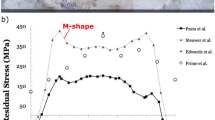Abstract
Two technologies, rotary friction welding and magnetic pulse welding/forming, have been developed to produce joints in various metal–metal and metal–non-metal combinations. For the rotary friction welding process, the techniques have been successfully developed to allow high-quality reliable joints for both titanium–stainless steel and titanium–aluminium combinations. The titanium–stainless steel configuration has reached a high level of maturity such that since the final qualification was achieved, about 200 flight units have been manufactured and sold in the last 11 years, with a steady demand over time. This includes ten configurations and two different families concerning length, wall thickness and outer diameter. For the titanium–aluminium transition joint, development and qualification activities were successfully performed in three different geometries: \({\raise0.7ex\hbox{$1$} \!\mathord{\left/ {\vphantom {1 4}}\right.\kern-\nulldelimiterspace} \!\lower0.7ex\hbox{$4$}}^{\prime\prime}\), \({\raise0.7ex\hbox{$3$} \!\mathord{\left/ {\vphantom {3 8}}\right.\kern-\nulldelimiterspace} \!\lower0.7ex\hbox{$8$}}^{\prime\prime}\), and \({\raise0.7ex\hbox{$1$} \!\mathord{\left/ {\vphantom {1 2}}\right.\kern-\nulldelimiterspace} \!\lower0.7ex\hbox{$2$}}^{\prime\prime}\). The testing campaigns were designed to seek the performance limits of the units and this allowed an improved understanding and higher confidence level of the final product. For the challenge of obtaining a reliable join between metals and non-metals, the production of aluminium to carbon fibre tube joints was achieved with the MPW technology. From the obtained results, the friction-based model for the joint was confirmed, and it was also possible to conclude that the discharge energy plays a critical role in the joint strength. It was also observed that to maintain the same joint strength, the discharge energy needs to be increased when the flyer wall thickness and joint diameter are also increased. Furthermore, the gap to the aluminium mandrel, corresponding to the admissible deformation possible to impose within the elastic regime of these tubes, should not only be considered to avoid damaging the CFRP tubes with the impact/deformation, but can also be used as a control parameter for the joint resistance, since it is this elastic deformation that in part determines the contact force between the two materials. This technology proved to be a viable approach to performing 40 mm diameter tubular joints between aluminium and CFRP tubes. However, for a full characterization of the effect of the discharge energy on the joint strength, it is necessary to produce more samples to establish a trend, as well as confirming its reproducibility.
















Similar content being viewed by others
References
Morris, M.: Titanium-alloy, metallic-fluid heat pipes for space service. NASA Technical Memorandum 79132 (1979)
Houssin-Agbomson, D., et al.: Study of potential leakage on several stressed fittings for hydrogen pressures up to 700 bar. Int. J. Hydrogen Energy. 37, 17509–17516 (2012). https://doi.org/10.1016/j.ijhydene.2012.04.149ff
Pasang, T., et al.: Characterisation of intermetallic phases in fusion welded commercially pure titanium and stainless steel 304. J. Metals 8, 863 (2018). https://doi.org/10.3390/met8110863
Seshagir, P.C., et al.: Improvement of mechanical properties of aluminium–copper alloy (AA2219) GTA welds by Sc addition. Sci. Technol. Weld. Join. 13(2), 146–158 (2008). https://doi.org/10.1179/174329308X283866
Riley D., et al.: Design for Demise techniques to reduce re-entry casualty risk. In: 66th International Astronautical Congress, Jerusalem, Israel, IAC-15, A6, 4, 5, x30058 (2015)
Elmer, J.W., Kautz, D.D.: Fundamentals of friction welding (1993). https://doi.org/10.31399/asm.hb.v06.a0001349
Meisnar, M., et al.: Microstructural characterisation of rotary friction welded AA6082 and Ti-&Al-4V dissimilar joints. Mater. Des. 132, 188–197 (2017). https://doi.org/10.1016/j.matdes.2017.07.004
van Loo, F.J., et al.: Diffusion in the titanium–aluminium system-I. Interdiffusion between solid Al and Ti or Ti-Al alloys. Acta Metall. 21(1), 61–71 (1973). https://doi.org/10.1016/0001-6160(73)90220-4
Sujata, M., et al.: On the formation of TiAl3 during reaction between solid Ti and liquid Al. J. Mater. Sci. Lett. 16, 1175–1178 (1997). https://doi.org/10.1023/A:1018509026596
Mostafa, M.: On the kinetics of TiAl3 intermetallic layer formation in the titanium and aluminum diffusion couple. Intermet. J. 32, 297–302 (2013). https://doi.org/10.1016/j.intermet.2012.08.017
Shete, N., et al.: A review paper on rotary friction welding. In: International conference on ideas – impact and innovation in mechanical engineering, vol. 5, issue 6 (2017) (ISSN: 2321-8169)
A. Bernard, et al.: Transition joints: dissimilar metal welding solution for space propulsion applications. In: Space propulsion conference (2014)
Omnidea-RTG.: TSJ Development Report, 433-TSJ-TN-006 (2008)
Omnidea-RTG.: 433-ATW-TN-001.02—Al-Ti Welding—Literature Review (2014)
Acknowledgements
The authors would like to acknowledge the effort put by IWS on the development and tuning of RFW technology over the different transition joint configurations and materials. The authors would like to highlight the strong support given by ESA/ESTEC personnel throughout the several transition joint activities.
Author information
Authors and Affiliations
Corresponding author
Additional information
Publisher's Note
Springer Nature remains neutral with regard to jurisdictional claims in published maps and institutional affiliations.
Rights and permissions
About this article
Cite this article
Carrolo, E., Fernandes, N., Trigueiro, J. et al. Development of metallic transition joints for space propulsion systems applications. CEAS Space J 15, 169–181 (2023). https://doi.org/10.1007/s12567-021-00420-1
Received:
Revised:
Accepted:
Published:
Issue Date:
DOI: https://doi.org/10.1007/s12567-021-00420-1




